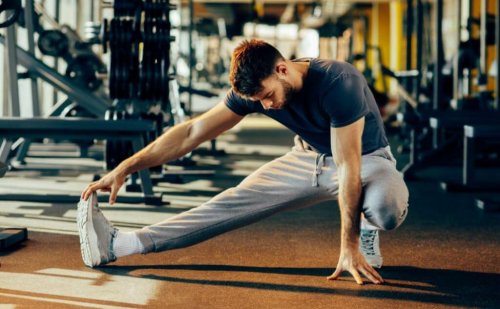Muscle Deterioration: Causes and Tips for Avoiding it

Very demanding workouts, poor nutrition, and aging are among the main causes of muscle deterioration. However, here are some tips to prevent it and keep your muscles in the best possible condition.
You might like: What Muscles do you Work Out on a Rowing Machine?
Muscle deterioration is when the condition of your muscles, tendons, and joints begin declining due to various reasons. The consequences on the body are mostly negative. Fortunately, you can take preventive measures to reduce the effects of muscle deterioration.
What causes muscle deterioration?
It’s worth mentioning that muscle deterioration isn’t the same as muscular atrophy. Both of those health issues affect the muscles for different reasons and in different ways. Muscle deterioration can occur for the following reasons:
- Workouts that are too strenuous and difficult.
- An incorrect technique or poor execution of exercises.
- Lack of essential nutrients such as proteins and vitamins.
- Aging.
As a result of the reasons above, muscle deterioration and wear on the tendons and joints can occur. So, it’s important to take good care of your body, especially when you’re demanding a lot from your muscles.
The symptoms of muscle deterioration are usually muscle fatigue, sores, injury, and difficulty in performing movements.
You might like: What’s the Meaning of Muscle Overload?
Tips to avoid muscle deterioration
In order to prevent muscle deterioration and have a healthy body, keep the following tips in mind and apply them to your daily life:
1. Eat a balanced diet
Diet is a key factor in the life of an athlete. It’s imperative that the body receives all the nutrients it needs to keep the body functioning properly.

Also, the diet should be according to your needs. In other words, your diet will depend on your age, height, weight, and the activities and exercises that you do. For this reason, it’s a good idea to see a nutritionist who can give you proper diet and nutrition advice for your individual body and needs.
It’s worth mentioning that fast foods, processed foods, sugary drinks, and sweets are mostly just harmful to the body. It’s best to eat a diet full of fruits, vegetables, and natural proteins.
2. Be careful with your workouts
Practicing any sport can provide you with a number of wonderful benefits. However, doing too much or working out too hard isn’t healthy. On the contrary, it can be harmful in many different ways.
Understandably, many sports demand intense and very frequent sessions. However, steps should be taken to avoid injury, muscle deterioration, pain, and other problems. Some of the best prevention includes:
- Warm-up properly before each workout.
- Take cold showers after exercise to promote muscle recovery.
- Go to the physical therapist to get massage therapy, and heat and cold treatments, among others.
3. Hydrate to prevent muscle deterioration
Keeping the body well hydrated before, during, and after exercise is vital to avoid muscle deterioration. This is because the lack of hydration can cause problems in muscle performance.
In addition, dehydration disrupts the body’s natural balance, causing muscle fibers fatigue, a lack of lubrication in the joints, and muscle cramps.
Therefore, water can never be scarce in your workouts, nor outside them. Beyond shakes, supplements or energy drinks, water is the best option if hydration is involved.
4. Don’t underestimate the importance of stretching
Professional and amateur athletes alike always put a lot of emphasis on warming up before exercise. However, stretching at the end is equally important. The reason is that the muscles need to gradually relax after all the tension they built up during the workout routine.
Therefore, stretching after working out is a very valuable habit for preventing soreness, muscle fatigue, deterioration, and cramps. In turn, warming up actually helps oxygenate the muscles and increase their flexibility.

At the same time, your stretching technique should be as calm and gentle as possible. Stretching doesn’t have to hurt at all. The idea is to lengthen the muscle and release tension.
Muscle deterioration usually appears in athletes who’ve been training for many years. Then, certain muscles begin to deteriorate and parts of the body such as the knees or tendons are usually the most vulnerable.
For all these reasons, it’s time for you to start taking care of and keeping your body in good condition. Keep in mind that it’s very easy for factors such as aging and training to begin to deteriorate your muscles. However, applying these tips to your life can help preserve your well-being, make you feel better and also perform better.
Very demanding workouts, poor nutrition, and aging are among the main causes of muscle deterioration. However, here are some tips to prevent it and keep your muscles in the best possible condition.
You might like: What Muscles do you Work Out on a Rowing Machine?
Muscle deterioration is when the condition of your muscles, tendons, and joints begin declining due to various reasons. The consequences on the body are mostly negative. Fortunately, you can take preventive measures to reduce the effects of muscle deterioration.
What causes muscle deterioration?
It’s worth mentioning that muscle deterioration isn’t the same as muscular atrophy. Both of those health issues affect the muscles for different reasons and in different ways. Muscle deterioration can occur for the following reasons:
- Workouts that are too strenuous and difficult.
- An incorrect technique or poor execution of exercises.
- Lack of essential nutrients such as proteins and vitamins.
- Aging.
As a result of the reasons above, muscle deterioration and wear on the tendons and joints can occur. So, it’s important to take good care of your body, especially when you’re demanding a lot from your muscles.
The symptoms of muscle deterioration are usually muscle fatigue, sores, injury, and difficulty in performing movements.
You might like: What’s the Meaning of Muscle Overload?
Tips to avoid muscle deterioration
In order to prevent muscle deterioration and have a healthy body, keep the following tips in mind and apply them to your daily life:
1. Eat a balanced diet
Diet is a key factor in the life of an athlete. It’s imperative that the body receives all the nutrients it needs to keep the body functioning properly.

Also, the diet should be according to your needs. In other words, your diet will depend on your age, height, weight, and the activities and exercises that you do. For this reason, it’s a good idea to see a nutritionist who can give you proper diet and nutrition advice for your individual body and needs.
It’s worth mentioning that fast foods, processed foods, sugary drinks, and sweets are mostly just harmful to the body. It’s best to eat a diet full of fruits, vegetables, and natural proteins.
2. Be careful with your workouts
Practicing any sport can provide you with a number of wonderful benefits. However, doing too much or working out too hard isn’t healthy. On the contrary, it can be harmful in many different ways.
Understandably, many sports demand intense and very frequent sessions. However, steps should be taken to avoid injury, muscle deterioration, pain, and other problems. Some of the best prevention includes:
- Warm-up properly before each workout.
- Take cold showers after exercise to promote muscle recovery.
- Go to the physical therapist to get massage therapy, and heat and cold treatments, among others.
3. Hydrate to prevent muscle deterioration
Keeping the body well hydrated before, during, and after exercise is vital to avoid muscle deterioration. This is because the lack of hydration can cause problems in muscle performance.
In addition, dehydration disrupts the body’s natural balance, causing muscle fibers fatigue, a lack of lubrication in the joints, and muscle cramps.
Therefore, water can never be scarce in your workouts, nor outside them. Beyond shakes, supplements or energy drinks, water is the best option if hydration is involved.
4. Don’t underestimate the importance of stretching
Professional and amateur athletes alike always put a lot of emphasis on warming up before exercise. However, stretching at the end is equally important. The reason is that the muscles need to gradually relax after all the tension they built up during the workout routine.
Therefore, stretching after working out is a very valuable habit for preventing soreness, muscle fatigue, deterioration, and cramps. In turn, warming up actually helps oxygenate the muscles and increase their flexibility.

At the same time, your stretching technique should be as calm and gentle as possible. Stretching doesn’t have to hurt at all. The idea is to lengthen the muscle and release tension.
Muscle deterioration usually appears in athletes who’ve been training for many years. Then, certain muscles begin to deteriorate and parts of the body such as the knees or tendons are usually the most vulnerable.
For all these reasons, it’s time for you to start taking care of and keeping your body in good condition. Keep in mind that it’s very easy for factors such as aging and training to begin to deteriorate your muscles. However, applying these tips to your life can help preserve your well-being, make you feel better and also perform better.
All cited sources were thoroughly reviewed by our team to ensure their quality, reliability, currency, and validity. The bibliography of this article was considered reliable and of academic or scientific accuracy.
- A Balanced Diet. (1952). Nutrition Reviews. https://doi.org/10.1111/j.1753-4887.1952.tb01052.x.
- Campbell B, Kreider R, Ziegenfuss T, et al (2007). International Society of Sports Nutrition position stand: Protein and exercise. Journal of the International Society of Sports Nutrition. https://doi.org/10.1186/1550-2783-4-8.
- EPA Office of Water. (2006). Water Management Fact Sheet: Energy Conservation.
- Woods, K., Bishop, P., & Jones, E. (2007). Warm-up and stretching in the prevention of muscular injury. Sports Medicine. https://doi.org/10.2165/00007256-200737120-00006.
- Instituto Nacional del Cáncer. Atrofia muscular. Disponible en: https://www.cancer.gov/espanol/publicaciones/diccionarios/diccionario-cancer/def/atrofia-muscular.
- Bodine S. Disuse-induced muscle wasting. The International Journal of Biochemistry & Cell Biology 2013;45(10):2200-2208. Disponible en: https://www.sciencedirect.com/science/article/abs/pii/S1357272513001957.
- Clínica Mayo. Síndrome de Guillain-Barré. Disponible en: https://www.mayoclinic.org/es-es/diseases-conditions/guillain-barre-syndrome/symptoms-causes/syc-20362793.
This text is provided for informational purposes only and does not replace consultation with a professional. If in doubt, consult your specialist.








